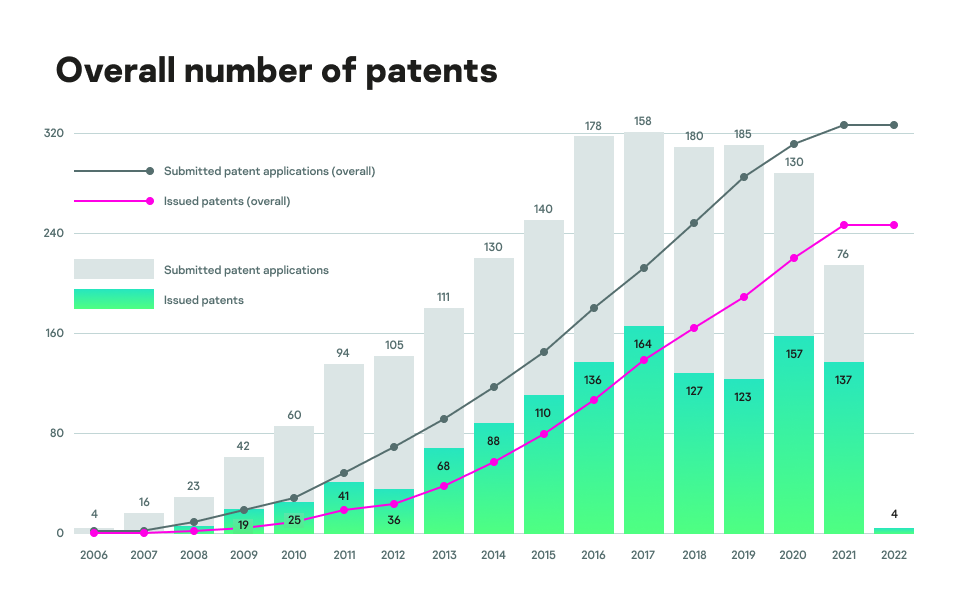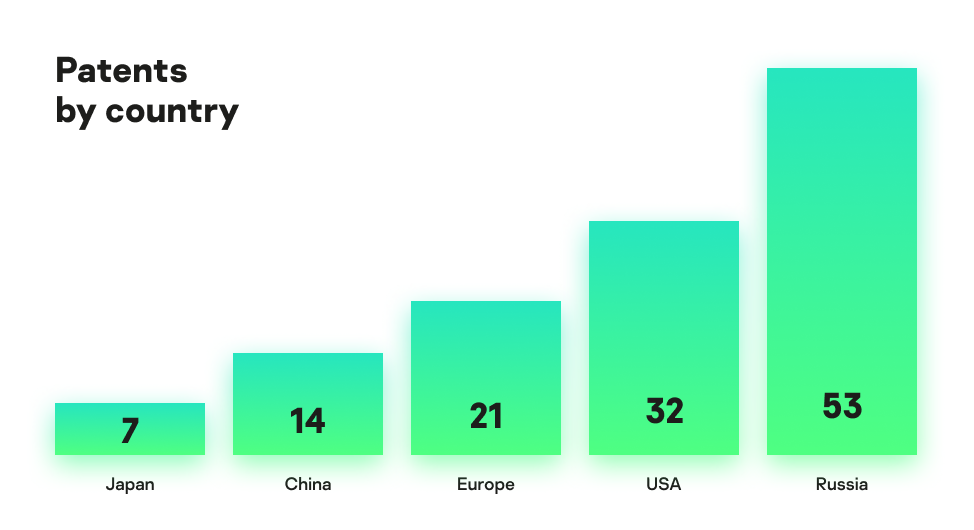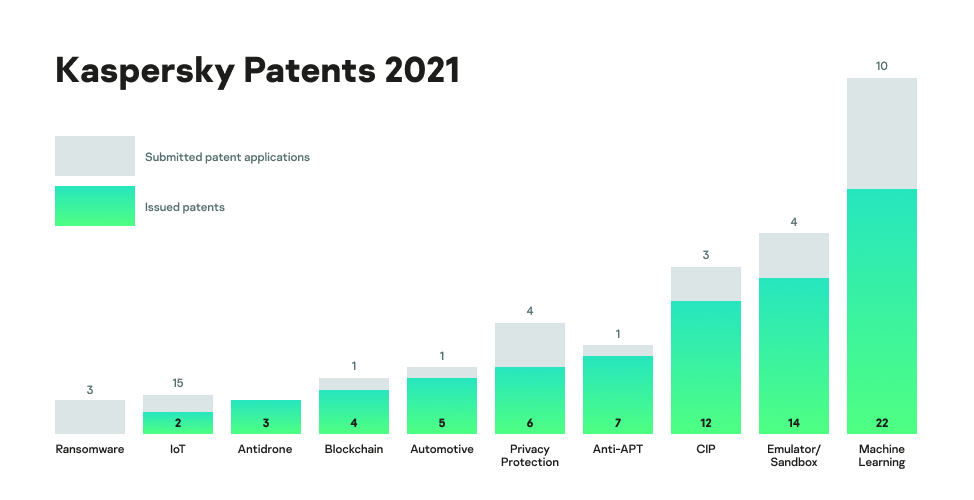January 25, 2022
Our 2021 patent-wise in review: the most U.S. patents, and many more around the world too.
Hi folks!
I simply must share this good, no – wonderful – news: we took out the most patents by any Russian-origin company in the U.S.A. in 2021! And we were a real trend-bucker, for in 2021 there was a fall of 7.5% in the number of patents registered in the country.
“In the annual patent ranking analysis published by IFI Claims Direct, Kaspersky has been named the top Russian company patented in the US with 43 patents published in 2021. Throughout its history the company has received 412 patents in the U.S. alone, with more than 1200 patents around the world, including Russia, the EU, China and Japan.”
// Btw: despite the overall fall in the number of patents issued last year, those issued for machine learning and quantum computing rose. This is just as quick reminder, in case you weren’t aware, of where this modern world is heading ).
A big thanks from me to all the team in our IP department. Always working hard, working smart, and working successfully (remember the victories over patent trolls, and the antitrust wins against Microsoft and Apple?). And a big thanks too to our developers who came up with our world-beating technologies in the first place – and that’s no mindless marketing hyperbole: our tech wins in independent tests more than any other. Oh da!
This super news about our patents got me thinking… Why don’t we take a closer look at our 2021 patent successes – not just the how many, but also the which, where, how and when? Yes, why not? After all, my patent-blogposts in the past have been popular. It’ll also be a nice complement to my 2021 review…
All righty. Here we go!…
In 2021 we obtained 137 patents and applied for a further 76. This brings our totals to 1240 patents and 392 applications. Here are those figures added to our historical patent graph:

Here’s the geography of our patent activity from last year:

And here are our portfolio’s totals and geographical spread overall:

Now let’s have a look at the main sub-sectors our patents cover (the sector being cybersecurity on the whole) ->
 (*) CIP = Critical infrastructure protection
(*) CIP = Critical infrastructure protection
So what needs pointing out here?
First, that AI machine learning is a global trend. And not only in intellectual property portfolios but in technology in general. Machine learning in a way magnifies the expert knowledge of humans; it adds heavy – high-volume – lifting, which humans on their own would never be able to do in the short timeframes computers manage to. Thus it is human expertise + machine learning + Big Data (aka – HuMachine) that forms the synergy that protects you from more than 380,000 new malicious programs every day!
Second, the Internet of Things (IoT) and critical infrastructure protection (CIP). The former is developing at a crazy-high speed, seeing homes, kettles, vacuum cleaners, fridges, etc., etc., all getting connected to the internet. Cybersecurity often takes a back seat in the design of IoT kit, so we step in to help secure it all. There’s a similar situation with CIP – but for a different reason: for example, legacy industrial automation systems are connecting to the internet, but with a marked reluctance to introduce cybersecurity at the same time – due to innate conservatism (if it works – don’t touch it).
And finally, there are two other interesting directions on the graph there. There’s antidrone technology – the new and very promising business of keeping pesky drones at bay. And there’s anti-ransomware: while the rest of the cybersecurity industry is doing abysmally in the fight against this scourge (able to only protect against 50% of ransomware – if that, as shown in independent testing), we couldn’t be doing better – literally (100%!). So it perhaps comes as no surprise that we already have 13 patents in our portfolio and 17 patents pending for ransomware technologies. And there’ll be more!…
In closing, brief descriptions of the most interestingly pioneering patents we registered in 2021 (btw: the ‘hit-parade’ from 2020 – here).
US11175976: ‘System and method of generating data for monitoring of a cyber-physical system for early determination of anomalies’. This technology can be applied outside the bounds of cybersecurity too – to ensure the continuity of manufacturing processes on the whole. It basically helps forecast errors or unsanctioned actions in cyber-physical systems. More details on this tech, which we call MLAD – here.
US11170103: ‘Method of detecting malicious files resisting analysis in an isolated environment’. Advanced sandboxed-related behavioral analysis on a virtual machine. This ‘under the hood’ tech is used in our sandbox, KATA, and EDR/MDR solutions.
US11005880: ‘System and method of blocking a computer attack on a means of transportation’. Since cars these days are more computer than automobile (remember Die Hard 4?!) – their ECUs need protecting. This is the tech that does it.
And that’s it for your K-patent-2021 update folks. Stay safe and protected – and that goes for your digital devices too, be they in your pocket, car, or factory!…

